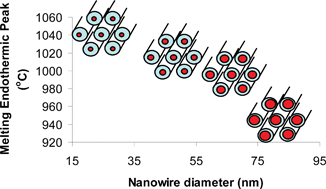Size dependent thermal properties of embedded crystalline germanium nanowires
Abstract
Here we report the size-dependent melting points of crystalline germanium

* Corresponding authors
a
Department of Chemistry, Materials Section and Supercritical Fluid Centre, University College Cork, Cork, Ireland
E-mail:
j.holmes@ucc.ie
Fax: +353 (0)21 4274097
Tel: +353 (0)21 4903608
Here we report the size-dependent melting points of crystalline germanium

 Please wait while we load your content...
Something went wrong. Try again?
Please wait while we load your content...
Something went wrong. Try again?
G. Audoit, J. S. Kulkarni, M. A. Morris and J. D. Holmes, J. Mater. Chem., 2007, 17, 1608 DOI: 10.1039/B616216A
To request permission to reproduce material from this article, please go to the Copyright Clearance Center request page.
If you are an author contributing to an RSC publication, you do not need to request permission provided correct acknowledgement is given.
If you are the author of this article, you do not need to request permission to reproduce figures and diagrams provided correct acknowledgement is given. If you want to reproduce the whole article in a third-party publication (excluding your thesis/dissertation for which permission is not required) please go to the Copyright Clearance Center request page.
Read more about how to correctly acknowledge RSC content.
 Fetching data from CrossRef.
Fetching data from CrossRef.
This may take some time to load.
Loading related content
